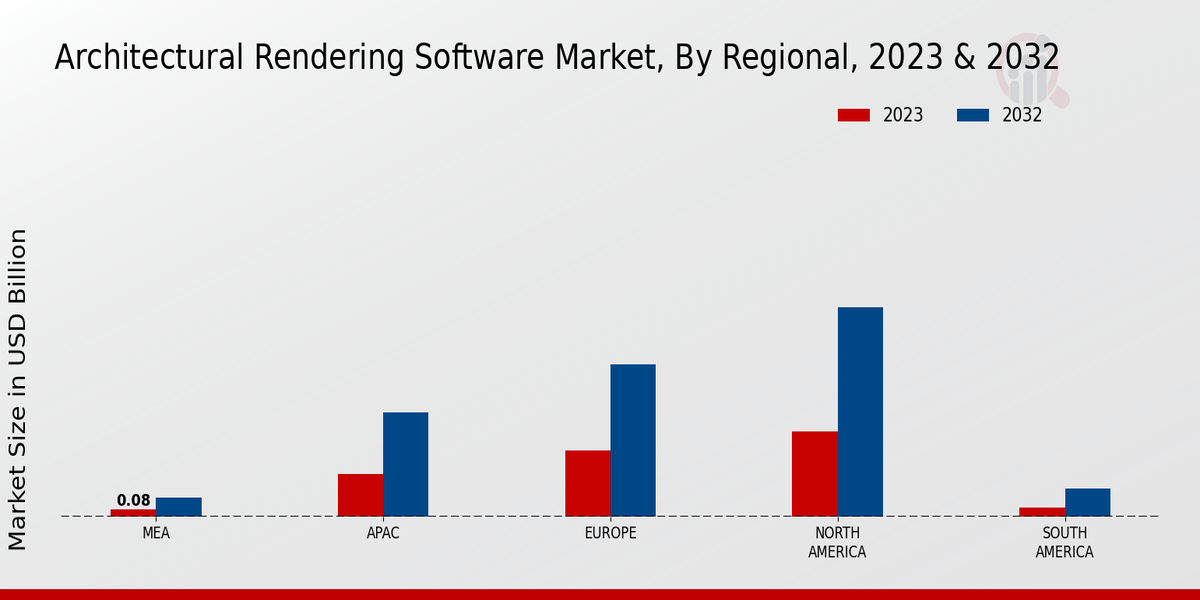Market Growth Projections
The Global Architectural Rendering Software Market Industry is poised for remarkable growth, with projections indicating an increase from 0.2 USD Billion in 2024 to 8.02 USD Billion by 2035. This growth trajectory suggests a compound annual growth rate (CAGR) of 39.88% from 2025 to 2035. Such figures highlight the increasing reliance on advanced rendering technologies in architecture, driven by factors such as technological advancements, rising demand for visualization, and the adoption of cloud-based solutions. The market's expansion reflects broader trends in the construction and design sectors, where high-quality visualizations are becoming essential for successful project execution.
Technological Advancements
The Global Architectural Rendering Software Market Industry is propelled by rapid technological advancements in rendering techniques. Innovations such as real-time rendering and virtual reality integration enhance the visualization process, allowing architects and designers to create more immersive experiences. These advancements not only improve the quality of renderings but also reduce the time required for project completion. As a result, the market is expected to grow from 0.2 USD Billion in 2024 to an estimated 8.02 USD Billion by 2035, reflecting a robust CAGR of 39.88% from 2025 to 2035. This growth indicates a strong demand for sophisticated rendering tools that can keep pace with evolving design requirements.
Rising Demand for Visualization
The increasing demand for high-quality visualization in architectural projects significantly drives the Global Architectural Rendering Software Market Industry. Clients and stakeholders now expect detailed and realistic representations of projects before construction begins. This trend is evident in various sectors, including residential, commercial, and industrial architecture, where visualizations play a crucial role in decision-making. As firms adopt advanced rendering software to meet these expectations, the market is poised for substantial growth. The anticipated rise from 0.2 USD Billion in 2024 to 8.02 USD Billion by 2035 underscores the importance of visualization in contemporary architecture, with a projected CAGR of 39.88% from 2025 to 2035.
Sustainability and Eco-Friendly Design
Sustainability has become a pivotal focus in architecture, influencing the Global Architectural Rendering Software Market Industry. As architects strive to create eco-friendly designs, rendering software that incorporates sustainable materials and energy-efficient solutions is increasingly in demand. This trend aligns with global efforts to reduce carbon footprints and promote environmentally responsible construction practices. The integration of sustainability features in rendering tools not only aids in design but also enhances the market appeal of architectural firms. The anticipated growth from 0.2 USD Billion in 2024 to 8.02 USD Billion by 2035, with a CAGR of 39.88% from 2025 to 2035, indicates a strong market response to the sustainability movement.
Increased Adoption of Cloud-Based Solutions
The shift towards cloud-based solutions is transforming the Global Architectural Rendering Software Market Industry. Cloud technology offers architects and designers the flexibility to access rendering software from various devices, facilitating collaboration among teams regardless of location. This trend is particularly beneficial for large-scale projects that require input from multiple stakeholders. The convenience and efficiency of cloud-based rendering solutions are likely to attract more users, contributing to market growth. As the industry evolves, the market is expected to expand from 0.2 USD Billion in 2024 to 8.02 USD Billion by 2035, with a CAGR of 39.88% from 2025 to 2035, reflecting the growing reliance on cloud technologies.
Growing Urbanization and Infrastructure Development
The rapid pace of urbanization and infrastructure development worldwide is a key driver of the Global Architectural Rendering Software Market Industry. As cities expand and new infrastructure projects emerge, the demand for architectural rendering software increases. This software is essential for visualizing complex urban designs and ensuring that projects meet regulatory standards and community expectations. The market is projected to grow from 0.2 USD Billion in 2024 to 8.02 USD Billion by 2035, reflecting a CAGR of 39.88% from 2025 to 2035. This growth is indicative of the critical role that rendering software plays in shaping modern urban environments.




















